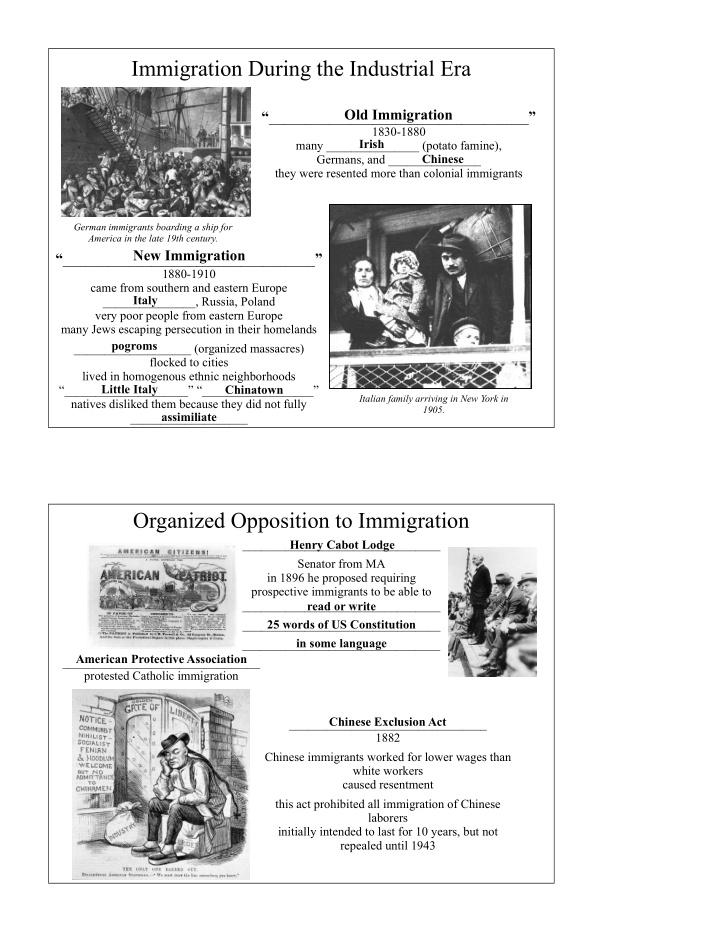



Immigration During the Industrial Era Old Immigration “ ___________________________________ ” 1830-1880 Irish many _______________ (potato famine), Germans, and _______________ Chinese they were resented more than colonial immigrants ! German immigrants boarding a ship for America in the late 19th century. New Immigration “ __________________________________ ” 1880-1910 came from southern and eastern Europe Italy _______________, Russia, Poland very poor people from eastern Europe many Jews escaping persecution in their homelands pogroms ___________________ (organized massacres) flocked to cities lived in homogenous ethnic neighborhoods Little Italy “____________________” “__________________” Chinatown ! Italian family arriving in New York in natives disliked them because they did not fully 1905. assimiliate ___________________ Organized Opposition to Immigration ________________________________ Henry Cabot Lodge Senator from MA in 1896 he proposed requiring prospective immigrants to be able to ________________________________ read or write 25 words of US Constitution ________________________________ in some language ________________________________ American Protective Association ________________________________ protested Catholic immigration Chinese Exclusion Act ________________________________ 1882 Chinese immigrants worked for lower wages than white workers caused resentment this act prohibited all immigration of Chinese laborers initially intended to last for 10 years, but not repealed until 1943
Urbanization urban areas grew twice as fast as the population people came to the cities for many reasons more exciting, public systems (plumbing, libraries, transportation, etc.), employment _____________________________ tenements ! poorly constructed and cramped five- or six-story buildings many had _____________________________; dark, no windows narrow, airless there was a horrible lack of social services _____________________________ in cities police, firefighters, water systems, garbage collection, parks, playgrounds rise in crime Unfair Conditions of Employment low pay, health and safety hazards, job insecurity Child Labor Fish cutters at a Canning Co in Maine. Ages range from 7 to 12. They live near the factory. The 7 year old boy in front, Byron Hamilton, has a badly cut finger but helps his brother regularly. Behind him is his brother George, age 11, who cut his finger half off while working. Ralph, on the left, displays his knife and also a badly cut finger. They and many youngsters said they were always cutting themselves. George earns a $1 some days usually 75 cents. Some of the others say they earn a $1 when they work all day. At times they start at 7 a.m. and work all day until midnight ! Some boys and girls were so small they had to climb up on to the spinning frame to mend broken threads and to put back the empty bobbins. Bibb Mill No. 1. Macon, Ga !
Rose Biodo, 10 years old, Philadelphia, Sept. 28, 1910. Working 3 summers. Minds baby and carries berries, two pecks at a time. This is the fourth week of school and the people here expect to remain two weeks more. Photo by Lewis W. Hine ! Child laborer, Newberry, South Carolina, 1908 ! breaker boy’s A _______________________ job was to separate impurities from coal by hand in a coal breaker. Breaker boys at the Eagle Hill colliery near Pottsville, Pennsylvania, 1884. Breaker boys sort coal in an anthracite coal breaker near South Pittston, Pennsylvania, 1911.
Triangle Shirtwaist Factory Fire ____________________________________________ March 25, 1911 one of the deadliest industrial disasters in the history of NYC resulted in the fourth highest loss of life from an industrial accident in US history 146 garment workers died (123 women and 23 men) most of the victims were recent Jewish and Italian immigrant women aged 16-23 locked theft the owners had ___________________ the doors to the stairwells and exit to prevent ___________________ and breaks unauthorized ___________________ many of the workers who could not escape the burning building jumped from the eighth, ninth, and tenth floors to the streets below the fire led to legislation requiring improved factory safety standards The Company Town all real estate, utilities, hospitals, stores, and other necessities or luxuries were owned by a single company ___________________________________________ company could place enormous markups on goods in ___________________________________________ a company store scrip _________________ company currency ________________________ issued to workers as their pay employees could exchange scrip for cash, but rarely at face value !
Recommend
More recommend